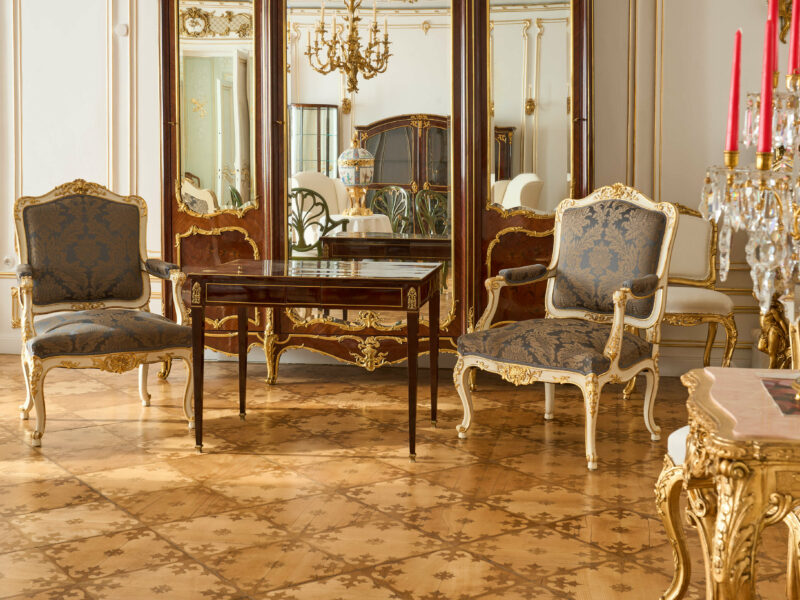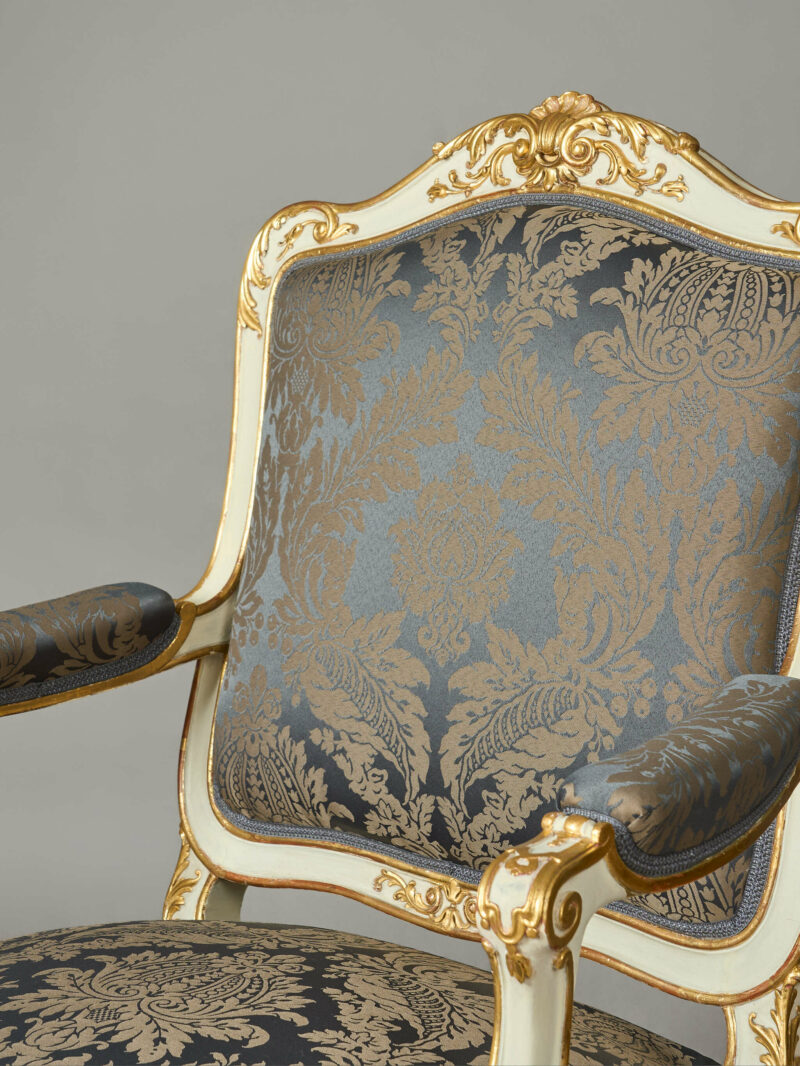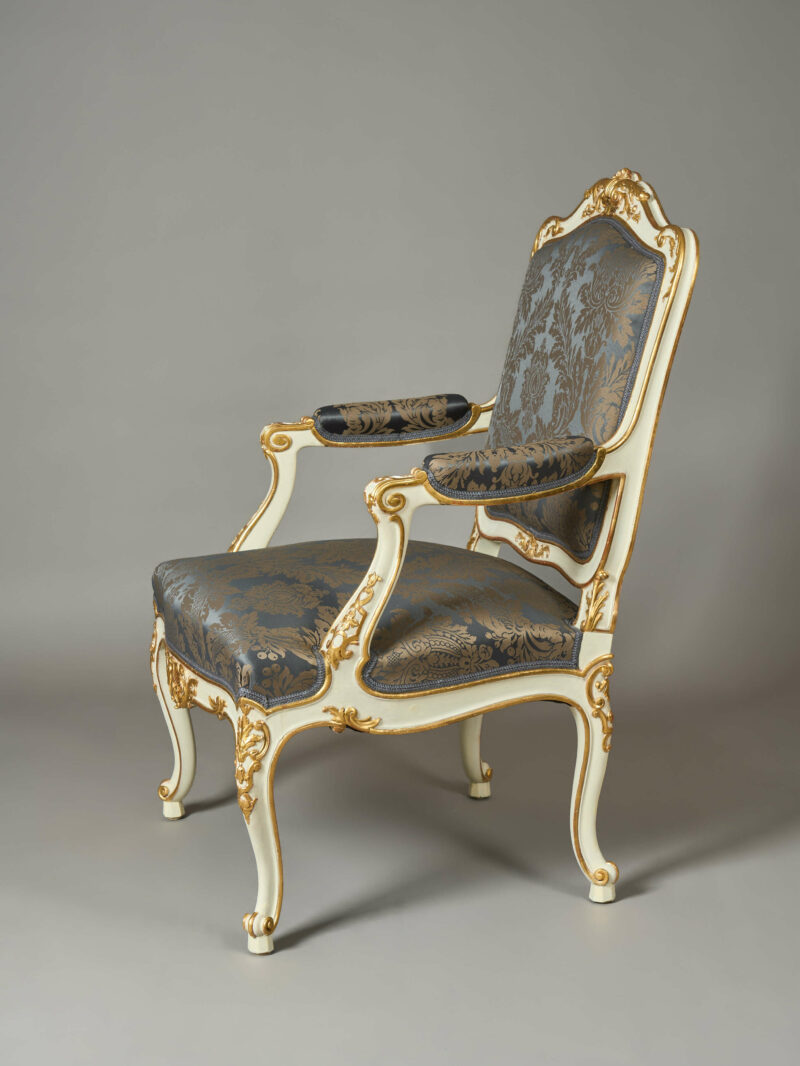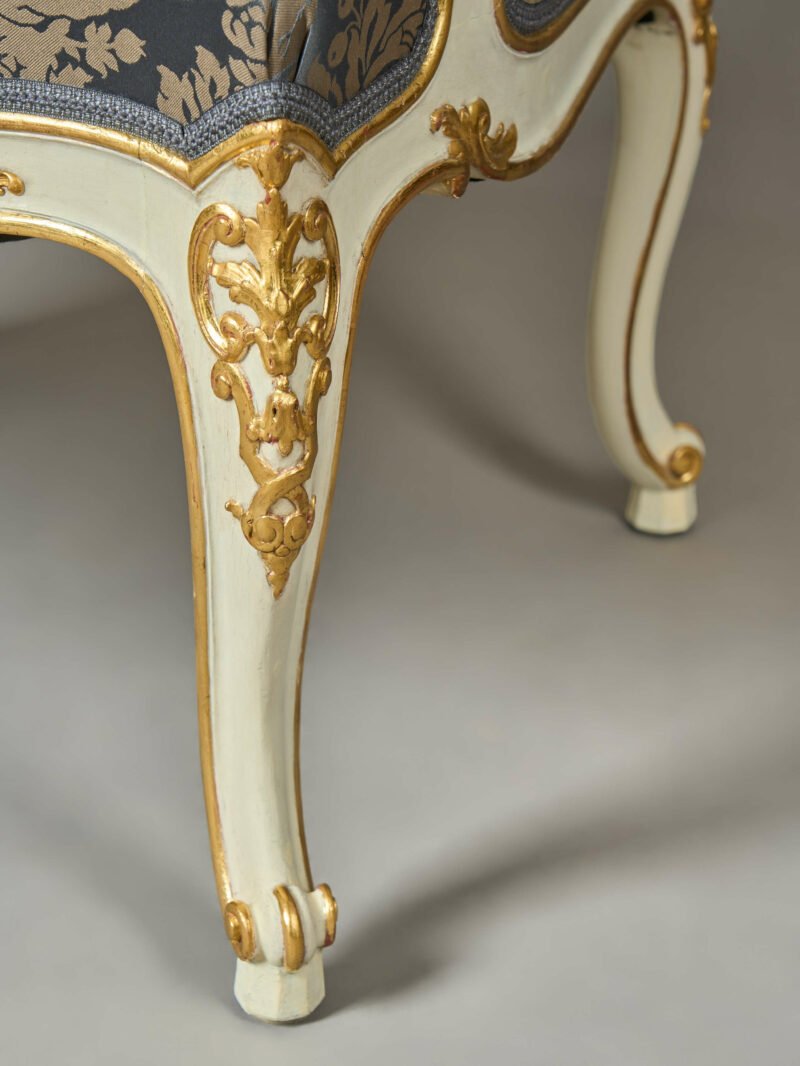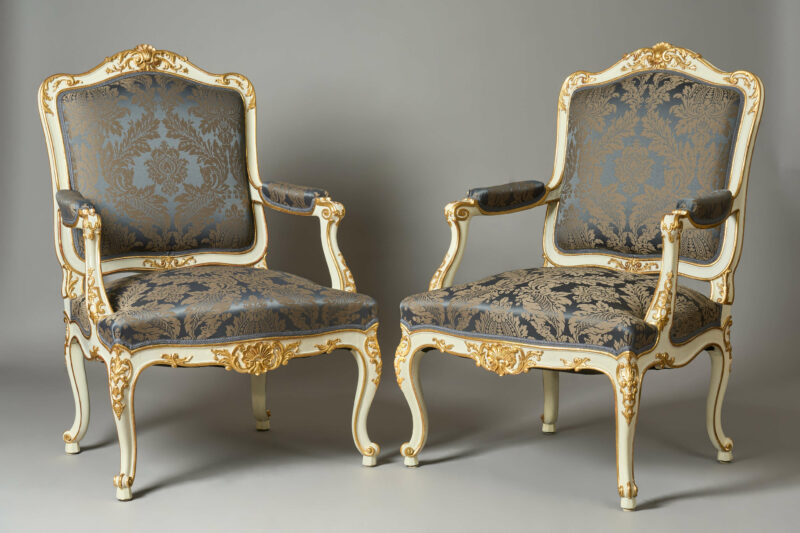
A Pair of Viennese Salon Fauteuils, end of the 19th century
A pair of very elegantly crafted salon armchairs, produced by one of the most significant furniture manufacturers and interior decorators of the Austro-Hungarian Empire, in the Baroque style that was highly popular at the time.
The curved hardwood frames are finely carved, painted white, and decorated with gold leaf. The seats, backrests, and armrests are upholstered.
The chairs have been carefully restored and newly upholstered in our workshops and covered with an elegant decorative fabric. Salon chairs of this kind were produced in Vienna by Portois & Fix for aristocratic and distinguished clientele. Today, these chairs fit seamlessly into an elegant interior but also serve as an intentional counterpoint in contemporary settings.
We also have a single salon fauteuil from Portois & Fix available, click HERE.
Portois & Fix:
Johann Fix founded an upholstery workshop in 1842 in Vienna’s 4th district, at Heumühlgasse 20, which was taken over in 1872 by his son Anton Fix (1846 Vienna – 1918 Vienna). It could be said that the company’s golden era began with the construction of the grand palaces along Vienna’s Ringstrasse, for which they produced many furnishings and interior decorations.
In 1873, Anton Fix participated in the Paris World Exhibition, returning home with numerous awards. It is believed that Fix met the French entrepreneur August Portois (1841 Brussels? – 1895 Nice) during the Vienna World Exhibition of 1873. However, it is very likely that the two had met before this event. Some sources place their first encounter in 1880. Auguste Portois worked for a trading company on Boulevard Haussmann in Paris — a business that provided complete interior furnishings for wealthy clientele.
Together with Isidor Blum, Portois founded the Société Commerciale de Paris in 1869, based in Paris. A branch office was located in Vienna at Kolowratring 7 (today’s Schubertring), named after the famous Austrian composer Franz Schubert. In 1874, Isidor Blum left the company, and August Portois continued the business independently in Vienna.
That same year (June 30, 1874), August Portois was appointed Purveyor to the Imperial and Royal Court. At that time, he operated a workshop in Vienna’s 9th district. Even Empress Elisabeth commissioned the Société Commerciale de Paris in 1874 to redecorate her rooms on the ground floor of Schönbrunn Palace. Several prestigious commissions followed, including the apartments of Crown Prince Rudolf at Prague Castle, the villa of Katharina Schratt, ships of the Imperial-Royal Danube Steamship Company, and imperial railway carriages. Portois also took part in the Vienna World Exhibition in 1873 and became a member of the Vienna Guild of Cabinetmakers in 1877.
In 1881, Anton Fix and August Portois founded their joint enterprise, “Portois & Fix,” and from then on offered complete interior design services. The official registration as a fine arts and furniture workshop followed in 1884.
The company’s rapid rise over the next ten years was greatly influenced by August Portois, who had by then acquired Austrian citizenship.
Portois & Fix’s first major public appearance took place at the International Electrical Exhibition in Vienna in 1883, gaining the company international acclaim. On the gallery level of the Rotunda, they presented several fully furnished salons and rooms illuminated with Edison’s newly invented light bulbs. This resulted in many international commissions from Russia, Egypt, Turkey, Switzerland, Germany, and beyond.
Subsequently, branch offices were established in the following cities: London, Paris, Milan, Budapest, Bucharest, Karlovy Vary, Wroclaw, Constantinople, Turin, Cairo, and Bombay. From the 1890s onward, Portois & Fix collaborated closely with artists, especially architects and designers associated with the Wiener Werkstätte (Vienna Workshop). The company produced designs by Otto Wagner, Josef Hoffmann, Adolf Loos, and Koloman Moser in their own workshops. By 1900, Portois & Fix had become one of the most important furniture manufacturers of the so-called “Viennese Modernism.”
Furniture created by the Wiener Werkstätte and the designers of this era can now be found in museums and private collections worldwide. When August Portois withdrew from the company due to illness on November 30, 1894, Anton Fix became the sole proprietor. August Portois passed away at the age of 54 in Nice. Between 1899 and 1901, based on plans by the architect Max Fabiani, a new company headquarters was built at Ungargasse 59 – 61 in Vienna’s 3rd district.
Strongly influenced by the modern architecture of Otto Wagner, Max Fabiani created one of the most advanced commercial buildings of its time. Born in Slovenia, Fabiani worked in Otto Wagner’s City Railway studio, where he not only designed the Portois & Fix headquarters on Ungargasse but also the Artaria Publishing House on Vienna’s Kohlmarkt, the Urania Observatory, and much more. Between 1905 and 1914, Fabiani also served as an advisor on architectural and art-historical matters to Crown Prince Franz Ferdinand.
From 1903 to 1904, he was a member of the Vienna Secession and, alongside Josef Plečnik, is regarded as one of the most important Slovenian architects. For the reception salon at the Paris World Exhibition in 1900, Portois & Fix executed a design by Max Fabiani — the so-called “Emperor’s Room” — for which Fabiani was awarded the Grand Prix.
In 1903, Anton Fix’s son Robert Fix joined the family business, bringing fresh creative impetus through his designs and ensuring the company’s continued success. On August 14, 1907, “Portois & Fix” was converted into a joint-stock company. Following the death of his father in 1918, Robert Fix left the company to pursue a career as a painter. Without doubt, “Portois & Fix” was one of Vienna’s most significant furniture producers at the turn of the century. Strategic expansion, product diversity, innovation, craftsmanship, and modern thinking all contributed to the company’s tremendous success.
Its clientele included: Imperial and Royal Houses, aristocracy, bankers, industrialists, manufacturers, the upper bourgeoisie, and entrepreneurs.
In addition to countless exhibitions at home and abroad, the company participated in many international exhibitions, including:
- The Vienna World Exhibition in 1873
- The Paris World Exhibition in 1900
- The Imperial-Royal Austrian Exhibition in London in 1906
Many of the works created by Portois & Fix were — both then and now — published and widely documented. Below is a small selection of prestigious references from the company Portois & Fix:
- Hunting Lodge Mayerling, Lower Austria, commissioned by Crown Prince Rudolf
- Café-Confectionery Demel, 1st District, Kohlmarkt 14
Stadtbahn Pavilion of His Imperial and Royal Majesty’s Court (Architecture: Otto Wagner), Hietzing, 13th District, Schönbrunner Schlossstraße
- Jewelry store A. E. Köchert, 1st District, Neuer Markt 15
- Men’s outfitter Knize, 1st District, Graben 13, in collaboration with Adolf Loos
- Flagship store of the textile company E. Braun & Co., 1st District, Graben 8
Loosbar (American Bar), 1st District, Kärntner Durchgang 10, together with Adolf Loos, 1909
- Restaurant and Delicatessen Zum Schwarzen Kameel, 1st District, Bognergasse 5, designed by Adolf Loos
- Palais Salm-Vetsera, 3rd District, Salesianergasse 11, which was demolished around 1916
In the 20th century, the company increasingly specialized in custom commissions, working — among others — for the Vienna State Opera, the Burgtheater, the Austrian Parliament, the Spanish Riding School, banks, and other public institutions. Portois & Fix was also commissioned for work at the Royal Palace of Aman.
Literature:
• Stefan Üner: Portois & Fix, in: Wagner, Hoffmann, Loos und das Möbeldesign der Wiener Moderne. Künstler, Auftraggeber, Produzenten, hrsg. v. Eva B. Ottillinger, Ausst. Kat. Hofmobiliendepot, Wien 20.3. – 7.10.2018, S. 145 – 147, ISBN 978−3−205−20786−3.
• Géza Hajós / Walther Brauneis: Die Profanbauten des III., IV. und V. Bezirkes. Wien: Schroll 1980 (Österreichische Kunsttopographie, 44.2), S. 172 f.
• Andreas Lehne: Jugendstil in Wien. Architekturführer. Wien: J & V Ed.2, 1990, S. 55 f.
• Bundesdenkmalamt [Hg.]: Dehio-Handbuch. Die Kunstdenkmäler Österreichs. Wien. II. bis IX. und XX. Bezirk. Wien 1993, S. 134
• Felix Czeike: III. Landstraße. Wien [u.a.]: Jugend & Volk 1984 (Wiener Bezirkskulturführer, 3), S. 68 f.
• Ottokar Uhl: Moderne Architektur in Wien von Otto Wagner bis heute. Wien [u.a.]: Schroll 1966, Register
• Friedrich Achleitner: Österreichische Architektur im 20. Jahrhundert. Ein Führer. Band 3⁄1: Wien. 1. – 12. Bezirk. Salzburg: Residenz-Verlag 1990, S. 132
• Dietmar Steiner: Architektur in Wien. 300 sehenswerte Bauten. Wien: Magistrat 1984, S. 142
• Pariser Esprit und Wiener Moderne – Die Firma Portois & Fix. Mit Beiträgen von Eva B. Ottillinger, Peter Haiko, Ulrike Scholda und Bernadette Decristoforo; Ausstellungskatalog, 2008.
• Vera J. Behal: Möbel des Jugendstils. Sammlung des Österreichischen Museums für angewandte Kunst. Prestel Verlag, Wien 1988, ISBN 3−7913−0547−6.
• Ingrid Haslinger: Kunde – Kaiser. Die Geschichte der ehemaligen k. u. k. Hoflieferanten. Schroll, Wien 1996, ISBN 3−85202−129−4.
• Dorothee Müller: Klassiker des modernen Möbeldesigns. Otto Wagner, Adolf Loos, Josef Hoffmann, Koloman Moser. Keysersche Verlagsbuchhandlung, Wien 1984, ISBN 3−87405−166−8.
• Maria Rennhofer: Koloman Moser – Leben und Werk 1868 – 1918. Brandstätter, Wien 2002, ISBN 3−85498−123−6.
